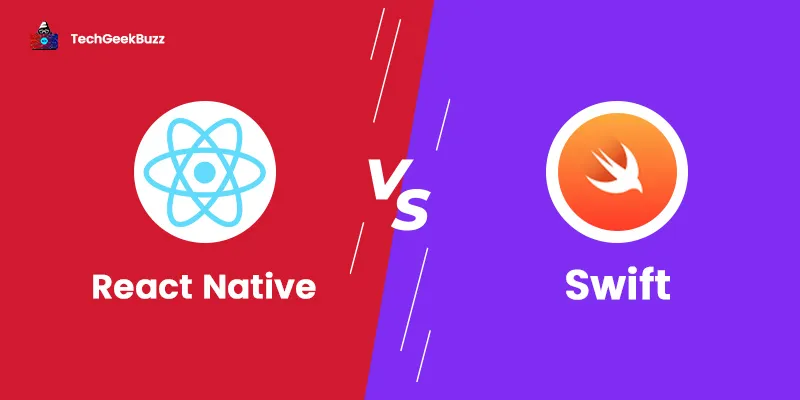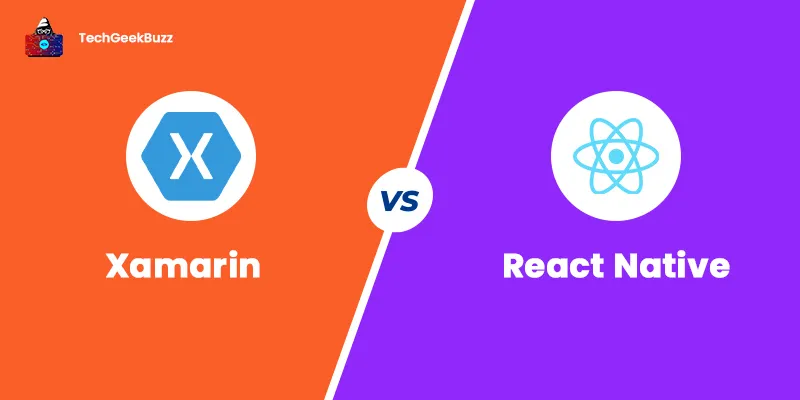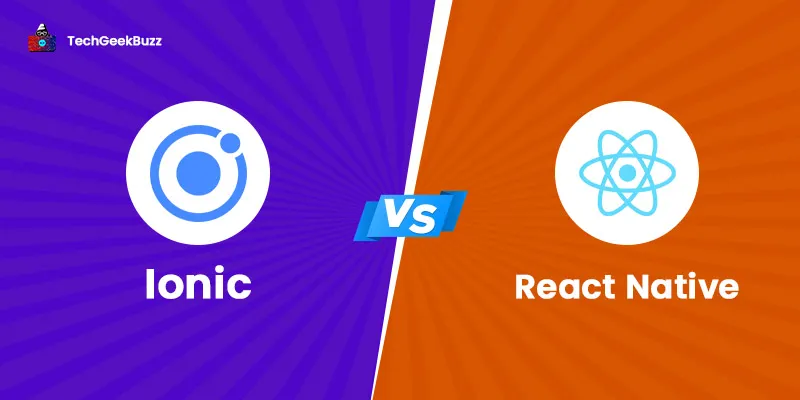Today, smartphones have become an inevitable part of this digital world, considering they have applications installed on them. Mobile applications come in handy to accomplish various activities, including shopping, getting food at doorsteps, finding a particular location, and the list is endless. With the increasing usage of mobile phones, there is a great rise in the development of mobile applications.
A plethora of technologies is available out there that accelerate and smoothen the development of mobile applications. Among all, two leading technologies are React Native and Swift. Both these technologies are developed by leading teach gains: Swift by Apple and React Native by Microsoft. Therefore, many developers often get confused about which one to choose between React Native and Swift.
React Native is an open-source framework that Microsoft has developed based on the React library. It is capable of creating cross-platform mobile applications. On the other hand, Swift is an open-source programming language for creating applications for iOS.
This article aims to demonstrate the differences between React Native and Swift. Also, it helps you get acquainted with the features, advantages, and disadvantages of React Native and Swift.
So, here it goes!
What is React Native?
React Native, also known as RN, is an open-source, JavaScript-based framework that helps developers create mobile applications that have a look and feel native to iOS and Android.
This framework enables developers to create mobile applications that run on various platforms with a single codebase. As a result, there is no need to write separate code bases for Android and iOS platforms. Developers can significantly save time and resources.
Furthermore, Facebook’s React library forms the basis for the React Native Framework. React is a JavaScript library that helps developers to create user interfaces. This framework is written by combining JavaScript and XML -Esque markup, which we collectively refer to as JSX . Today, React Native powers the world’s leading mobile applications, including Instagram, Facebook, and Skype.
History
React Native was developed by Meta (formerly Facebook) in 2015, and hence, it is a relatively new technology in the market. However, there is a story behind React Native coming to life.
When Meta decided to enable users to leverage their service on mobile devices, they did not go with building a native application for their service. Instead, they decided to run their service on a mobile web page using HTML5. However, this solution was not so efficient, leaving room for performance and security improvements.
In 2012, Mark Zuckerberg admitted that it was the biggest mistake that they had used HTML to create a mobile application that provides a native feel to users. He said it because Facebook’s mobile application created using HTML was unstable and did not retrieve data quickly.
Meta’s developer Jordan Walke, in 2013, leveraged JavaScript and found a method for creating UI elements for iOS applications. Later, they organized a Hackaton to discover the power of JavaScript for developing mobile applications. Hence, React Native came to life.
Initially, React Native could only develop applications for iOS. Later in 2015, the company made this framework to support the development of Android applications and finally unveiled it on March 26, 2015.
Features
Some notable features of React Native are as follows:
- Write Once, Use Anywhere: This feature of Reach Native enables developers to write code only once and use it to create applications for various platforms, including Android, iOS, and Windows. This means that they do not have to write code separately for Android, iOS, or Windows platforms.
- UI-Focused: Designing an intuitive user interface is one of the most concerning factors when it comes to mobile app development. However, with React Native, there is nothing to worry about UI since it is a UI-focused framework. It comes with excellent rendering capabilities.
- Live Reload: When you work with React Native, the screen splits into two panels. The first panel is where you can make changes to your code, and the second is where you can immediately observe the output as you make changes in the code.
- Reusable Components: The building blocks or components of this framework are reusable, and you can use them for developing React applications.
- Hot Reloading: When you make changes to your source code, you need to save it and reload the application to see the changes in the output. It is very tedious and time-consuming. React Native comes with the feature of hot reloading that lets you see changes made to the source code without reloading the entire application.
Advantages
The following are the remarkable benefits of React Native:
- It is an open-source framework, and hence, every developer out there can use it to create robust mobile applications.
- Since React Native is backed by Meta, it is sure that they will invest a lot of time, energy, and resources to make this framework more reliable. Also, it is certain that they will deliver upgrades regularly.
- It has a great community of developers and has been one of the favorite tools among developers since its inception. Consequently, if you face any difficulty while using this framework, you can get instant support from the community.
- React Native supports third-party libraries. Therefore, you can extend the features of this framework with the use of third-party libraries.
- Since codes developed using this framework are reusable, you can save a lot of development costs and time.
- The time required to develop applications using this framework is relatively lower than other frameworks.
- With React Native, you get access to debugging and error reporting tools.
Disadvantages
Here are the major downsides of React Native:
- You may get into a mess if you use the hot reloading feature many times consecutively.
- Since React Native is still new in the market and is in its progressing stage, you may face some debugging and compatibility issues.
- There is a lack of custom modules in React Native.
- As it reduces the development time, React Native does not reduce the time required for testing applications.
- It results in slow performance and does not support multithreading and multiprocessing.
When to Choose React Native?
Choosing React Native would be a great choice for creating a cost-effective application that requires live reloading and hot reloading features. In addition, if you want to create an application that works with both the major platforms, iOS and Android, go with React native.
What is Swift?
Swift is not any framework or library. Instead, it is a general-purpose, compiled programming language. It follows multiple programming paradigms, including object-oriented , imperative, structured, and declarative. This programming language was a replacement for the Objective-C language, which Apple Inc. used earlier before Swift’s inception.
Developed by Apple Inc., they designed this language based on the LLVM compiler . The company tried to design Swift that supports most features of Objective-C but in a safe manner so that it becomes easier to catch bugs. These features included dynamic dispatch, extensible programming, and late binding.
With Swift, it is possible to develop a wide range of applications. Also, they have incorporated it in XCode version 6. In addition, Swift has a human-readable syntax, and you can easily write and maintain programs written in this language. This language's modern software design approach makes it possible for developers to create high-performance and complex applications.
History
Chris Lattner, in 2010, initiated the development of Swift, along with some other programmers at Apple. While developing Swift, these programmers considered the features of various other programming languages, including Objective-C, Rust, Haskell, C#, Ruby and Python .
The Apple Worldwide Developers Conference (WWDC) application was the first application developed using Swift and was released publicly in 2014. At the same conference, Apple released the beta version of the language to a few Apple developers. However, the company said that it was not the final version of Swift.
Later, the company released Swift in December 2014 for iOS for Gold Master of Xcode version 6.0. As soon as there was the release of Xcode 6.1, the company released Swift 1.1. Furthermore, Apple released Swift 1.2 for Xcode 6.3.
In 2015, the company released Swift 2.0 at the Worldwide Developers Conference (WWDC). This version was available to the public for developing applications that they could publish in the App Store.
Later, the year 2016 witnessed the release of Swift 3.0, and the year 2017 witnessed the release of Swift 4.0. In just a year, the company released Swift 5.0. The latest and stable version of Swift is 5.6, released in March 2022.
Features
The following are the remarkable features of Swift:
- Powerful Generics: Generics refers to allowing various types, including integer, string, or user-defined types, to be a parameter that we can pass to a method, class, or interface. Swift provides powerful generics, allowing us to write reusable functions that you can use with any type.
- Native Error Handling: Swift is capable of handling errors at runtime through exception handling.
- Memory Safety: This language has the ability to manage the memory automatically. Also, it prevents unwanted and unsafe events to take place in your source code that make it behave differently.
- Memory Management: Swift comes with automatic reference counting (ARC) that manages your application’s memory usage. Therefore, there is no need to worry about the management of memory.
- Closure Syntax: The lightweight closure syntax of Swift enables you to write clean and clutter-free source code.
- Package Manager: It is a tool that works on various platforms and enables you to create, test, run, and package Swift libraries and executables.
Advantages
Some noteworthy advantages of Swift are as follows:
- Swift has easy and beginner-friendly syntax. Therefore, you can learn this language quickly.
- The error handling capability and the strong typing method make this language safer and more secure.
- It comes with dynamic libraries. As a result, you will not face the problem of memory logging. Also, there will be a reduced memory footprint.
- Anyone can use this language since it is open-source.
- It is faster than Objective-C and Python, which, in turn, reduces the development time.
Disadvantages
The following are the significant drawbacks of Swift:
- Swift is a new language as compared to other programming languages, like Java, C, C++ and Python . Therefore, it does not have a large community of developers as other languages have.
- Since it is a new language, there is a scarcity of expert and skilled Swift developers.
- It poorly interacts with other third-party tools and integrated development environments.
- It does not come with the hot-reloading feature. However, it is possible with the help of the Injection plugin for Xcode that lets you observe code changes in real-time.
When to Choose Swift?
With Swift, it is possible to create applications for only a single platform, i.e., the Apple ecosystem. When you need to develop applications that need the features of iOS and APIs, choosing Swift is ideal. Moreover, this programming language is ideal for creating applications that require complex UIs, high safety, and high memory management.
React Native vs Swift - A Head-to-Head Comparison
The following table highlights all the major differences between React Native and Swift:
|
Parameters |
React Native |
Swift |
|
Definition |
React Native is an open-source framework based on JavaScript. |
Swift is an open-source, multi-paradigm programming language. |
|
Language and Syntax |
React Native the JSP syntax, which is the syntax extension to JavaScript. |
The syntax of Swift is analogous to Objective-C, which is very clean and expressive. |
|
Usage |
The primary usage of React Native is to create applications that have a native look and feel to iOS and Android platforms. |
With Swift, you can create applications compatible with only iOS. |
|
Learning Curve |
React Native is based on JavaScript, which is one of the most popular languages among web developers. It has a low learning curve. |
It has a steep learning curve. For beginners, it seems pretty difficult to learn Swift since it is a new programming language. |
|
Supported Platforms |
It is a cross-platform framework compatible with Android, iOS, Android TV, Windows, and macOS. |
Swift is only compatible with the Apple ecosystem. |
|
Community |
Though RN is a new framework in the market, it leverages JavaScript, which has a vast community of developers. |
Swift is also a new language and has a limited community of developers. |
|
Development Cost |
It is a cost-effective solution. |
If you do not have any limitations on your budget, Swift is also good to go. |
|
Hot Reloading |
React Native supports the hot reloading feature. |
Swift does not support hot reloading. |
React Native vs Swift - Which One to Choose?
From the above discussion, we can conclude that React Native is capable of creating cross-platform applications, while Swift can create applications only for the Apple platform. This means that the applications you create using React Native can work on Android and iOS devices, whereas the ones you develop using Swift can work on only the iOS platform.
As a result, if your requirement is to create an application for only the iOS platform, Swift is the best choice. On the flip side, going with React native would be wise if you want your application to work on Android and iOS platforms.
Conclusion
This brings us to the end of our discussion on React Native vs Swift. We can also refer to the battle between React Native and Swift as cross-platform vs native development. This is because React Native is a framework for creating cross-platform applications, while Swift is a programming language for creating applications only for the iOS platform.
We recommend you choose between these technologies based on your requirements. For creating cross-platform applications, choose React Native. On the flip side, go with Swift if you want your application to work only on the iOS platform.
If you know any other differences between React Native and Swift, do let us know via the comments section.
People are also reading:




